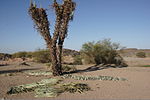- Hyphaene thebaica
-
Hyphaene thebaica
Doum palmDoum Palm in Northern Sudan Scientific classification Kingdom: Plantae (unranked): Angiosperms (unranked): Monocots (unranked): Commelinids Order: Arecales Family: Arecaceae Genus: Hyphaene Species: H. thebaica Binomial name Hyphaene thebaica
(L.) Mart.Hyphaene thebaica, with common names doum palm and gingerbread tree, is a type of palm tree with edible oval fruit. It is native to the Nile valley in Egypt and Sudan, and in riverine areas of northwestern Kenya.
Contents
Uses
Its fibre and leaflets are used by people along the Nile to weave baskets, such as in the material culture of the Manasir.
Sacred in tombs
It was considered sacred by the Ancient Egyptians and the seed was found in many pharaoh's tombs. On September 24, 2007, it was announced that a team of Egyptian archaeologists led by Zahi Hawass, discovered eight baskets of 3,000 year old doum fruit in King Tutankhamun's tomb. The fruit baskets are each 50 centimetres high, the antiquities department said. The fruit are traditionally offered at funerals.[1]
Food
The doum palm fruit-dates are also known in Eritrea as Akat, or Akaat in the Tigrinya language. The thin dried brown rind is made into molasses, cakes, and sweetmeats. The unripe kernels are edible. The shoots of the germinated seeds are also eaten as a vegetable.[2] In Egypt, the fruit is sold by street vendors, and is popular among children, gnawing its sweet yet sour hard fibrous flesh beneath the shiny hard crust.
A herb tea of doum dates is made in Egypt and believed good for hypertension. In Diu, Una and Saurashtra region of Gujarat (India), the tree is known as Hoka Tree and the red ripe edible fruit is known as Hoka.
References
- ^ ABC story: Fruit hamper found in King Tut's tomb
- ^ Facciola, S., Cornucopia, A Source Book of Edible Plants Kampong.
- Hyphaene thebaica in Brunken, U., Schmidt, M., Dressler, S., Janssen, T., Thombiano, A. & Zizka, G. 2008. West African plants - A Photo Guide. Forschungsinstitut Senckenberg, Frankfurt/Main.
External links
Wikimedia Foundation. 2010.




